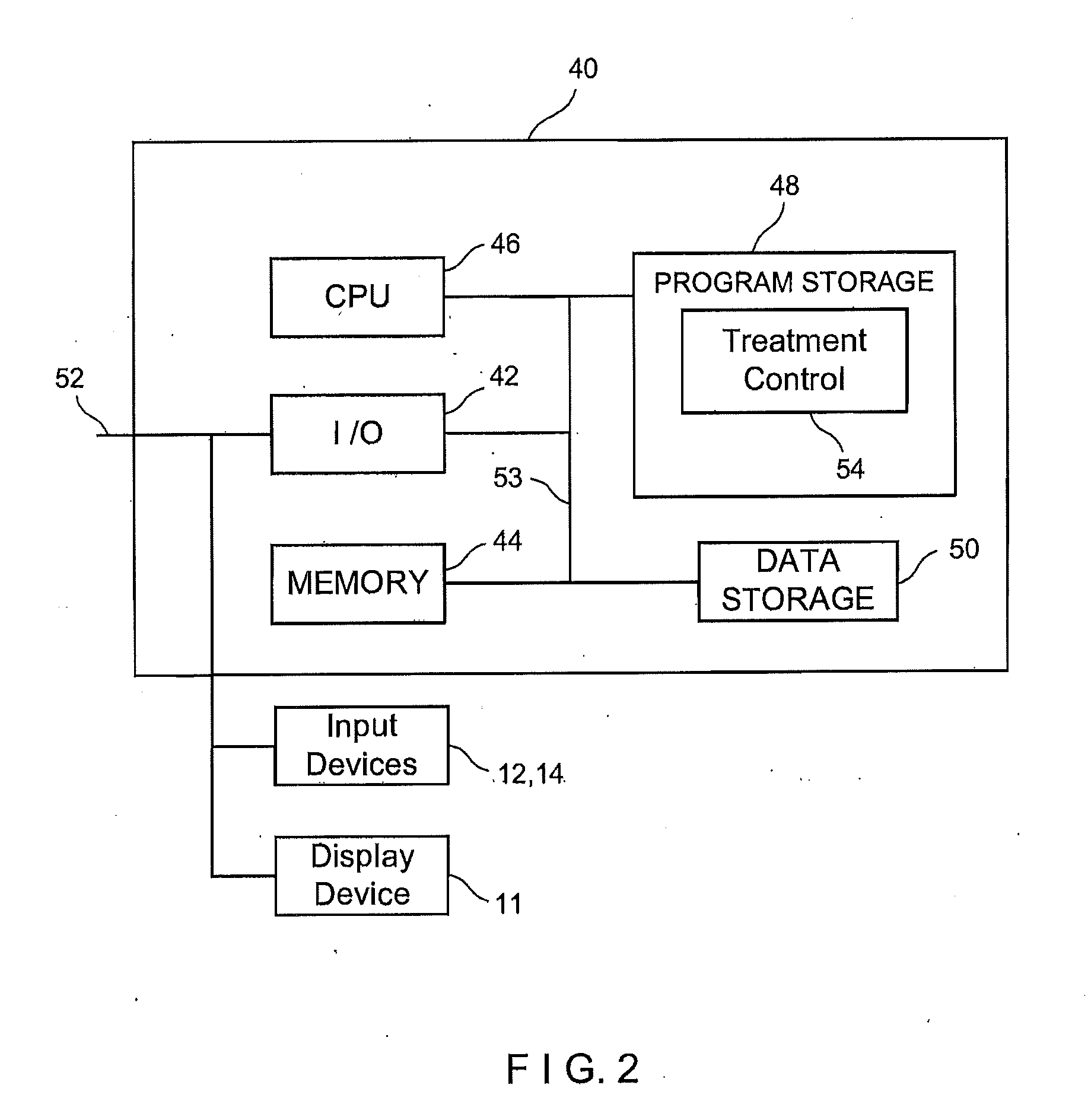System and Method for Estimating A Treatment Region for a Medical Treatment Device
a treatment region and system technology, applied in the field of control system for controlling a medical treatment device, can solve the problems of difficult or sometimes inability to place the electrodes in the correct location of the tissue, difficult to predict whether the selected locations will ablate the entire treatment target area, and modest two-dimensional treatment region may take at least 30 minutes to several hours to compl
- Summary
- Abstract
- Description
- Claims
- Application Information
AI Technical Summary
Benefits of technology
Problems solved by technology
Method used
Image
Examples
example 1
[0112]If V=2495 Volts; a=0.7 cm; and A=650 V / cm;
[0113]Then b2=1.376377
[0114]and then a cassini curve can be plotted by using eq. (5) above by solving for r, for each degree of theta from 0 degrees to 360 degrees.
[0115]A portion of the solutions for eq. (5) are shown in Table 1 below:
[0116]where M=a2 cos(2*theta); and L=sqrt(b4−a4 sin2(2*theta))
TABLE 1Thetar =r =r =r =(degrees)sqrt(M + L)−sqrt(M + L)sqrt(M − L)−sqrt(M − L)01.366154−1.366150011.366006−1.366010021.365562−1.365560031.364822−1.364820041.363788−1.363790051.362461−1.362460061.360843−1.360840071.358936−1.358940081.356743−1.356740091.354267−1.3542700101.351512−1.3515100111.348481−1.3484800121.34518−1.3451800131.341611−1.3416100141.337782−1.3377800151.333697−1.333700
[0117]The above eq. (6) was developed according to the following analysis.
[0118]The curve from the cassini oval equation was calibrated as best as possible to the 650 V / cm contour line using two 1-mm diameter electrodes with an electrode spacing between 0.5-5 cm a...
example 2
[0143](x1, y1)=(−0.005 m, 0 m)
[0144](x2, y2)=(0.001 m, 0.003 m)
[0145]Vo=1000 V
[0146]a=0.0010 m
[0147]d=0.006708 m
[0148]Using eqs. (10-13) above, the E-field values are determined for x, y coordinates on the grid, as shown in the spreadsheet at FIG. 16.
[0149]This method can also be used to determine the E-field values for devices having two plate electrodes or two concentric cylinders.
The Third Method
[0150]As an alternate method of estimating the treatment zone in real time, a predetermined set of values that define the outer boundary of a plurality of predetermined treatment zones (determined by FEA, one of the above two methods or the like) can be stored in memory as a data table and interpolation can be used to generate an actual treatment zone for a particular treatment area (e.g., tumor area).
[0151]Interpolation is commonly used to determine values that are between values in a look up table. For example if a value half way between 5 and 10 in the first row of the lookup table (se...
example 3
[0172]A device having 3 probes is used to treat a lesion where:
[0173]a=2.0 cm; b=1.0 cm; and φ=0 degrees
[0174]Using Table 2.1, θ1=90°, θ2=210°, and θ3=330°
[0175]Using Table 2.2, ε3=0.70
[0176]Therefore, when using the “Autoset Probes” feature, and eqs. (14) and (15) above, the (x,y) locations on the grid for each probe are calculated as follows:
Probe #1
[0177]x1=εj*a*cos (θi+φ)=0.70*2.0 cm*cos (90 degrees)=0
[0178]y1=εj*b*sin (θi+φ)=0.70*1.0 cm*sin (90 degrees)=0.70 cm
Probe #2
[0179]x2=εj*a*cos (θi+φ)=0.70*2.0 cm*cos (210 degrees)=−1.21 cm
[0180]y2=εj*b*sin (θi+φ)=0.70*1.0 cm*sin (210 degrees)=−0.35 cm
Probe #3
[0181]x3=εj*a*cos (θi+φ)=0.70*2.0 cm*cos (330 degrees)=1.21 cm
[0182]y3=εj*b*sin (θi+φ)=0.70*1.0 cm*sin (330 degrees)=−0.35 cm
[0183]Using Table 2.3, the firing sequence and respective polarity of the three probes will proceed as follows:
[0184](3 treatment pairs)[0185](+) Probe #1, (−) Probe #2[0186](+) Probe #2, (−) Probe #3[0187](+) Probe #3, (−) Probe #1
[0188]In another embodiment,...
PUM
 Login to View More
Login to View More Abstract
Description
Claims
Application Information
 Login to View More
Login to View More - R&D
- Intellectual Property
- Life Sciences
- Materials
- Tech Scout
- Unparalleled Data Quality
- Higher Quality Content
- 60% Fewer Hallucinations
Browse by: Latest US Patents, China's latest patents, Technical Efficacy Thesaurus, Application Domain, Technology Topic, Popular Technical Reports.
© 2025 PatSnap. All rights reserved.Legal|Privacy policy|Modern Slavery Act Transparency Statement|Sitemap|About US| Contact US: help@patsnap.com



